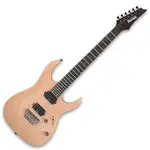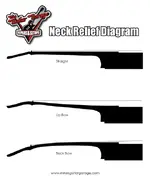philbagg
Just Killing Time
Hi all,
I'm thinking of doing some work on my guitar myself, and I'm mainly looking for thoughts/opinions/advice. The guitar is an Ibanez RGA121 Prestige, like this:

The first thing is a repair job.
I may be wrong on the terminology, but I believe there's a back-bow on the neck: basically, as if the neck bends backwards in a bow-shape. There's some fret-buzz on the 9th fret, the intonation is slightly off, and my pinch harmonics are dying out very quickly - as if the strings are touching the frets and causing them to cut off too soon.
I'm not saying this is a simple thing to look after, but is this something I could look at myself? Obviously, with great care being taken, without f***ing it up permanently. Have any of you ever done something similar before? Any guides?
The second thing is more of a modification: repaint.
As you can see from the picture above, the guitar is very plain looking, and I'd like something a little different. Once again, not an easy job I'm sure but have any of you ever done it before?
Thanks in advance
I'm thinking of doing some work on my guitar myself, and I'm mainly looking for thoughts/opinions/advice. The guitar is an Ibanez RGA121 Prestige, like this:

The first thing is a repair job.
I may be wrong on the terminology, but I believe there's a back-bow on the neck: basically, as if the neck bends backwards in a bow-shape. There's some fret-buzz on the 9th fret, the intonation is slightly off, and my pinch harmonics are dying out very quickly - as if the strings are touching the frets and causing them to cut off too soon.
I'm not saying this is a simple thing to look after, but is this something I could look at myself? Obviously, with great care being taken, without f***ing it up permanently. Have any of you ever done something similar before? Any guides?
The second thing is more of a modification: repaint.
As you can see from the picture above, the guitar is very plain looking, and I'd like something a little different. Once again, not an easy job I'm sure but have any of you ever done it before?
Thanks in advance



 Just don't go too far, and have an up bow!Loosen it maybe a 1/4 turn. If that seems better, but still not enough, another 1/4 turn is all I'd go. After that, I'd take it to a serious repair guy. The 9th fret buzzing seems in line with a back bow, but you may also just have a high fret, or the action is set a little low. Here again, a good repair guy can set up the guitar properly, and you'll save a lot of frustration. Go slow, and good luck.
Just don't go too far, and have an up bow!Loosen it maybe a 1/4 turn. If that seems better, but still not enough, another 1/4 turn is all I'd go. After that, I'd take it to a serious repair guy. The 9th fret buzzing seems in line with a back bow, but you may also just have a high fret, or the action is set a little low. Here again, a good repair guy can set up the guitar properly, and you'll save a lot of frustration. Go slow, and good luck.

